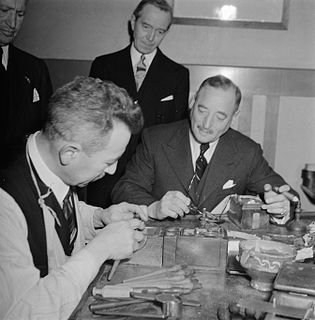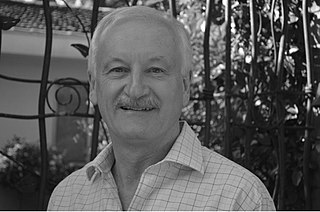Related Research Articles
De Beers Group is an international corporation that specialises in diamond mining, diamond exploitation, diamond retail, diamond trading and industrial diamond manufacturing sectors. The company is active in open-pit, large-scale alluvial, coastal and deep sea mining. It operates in 35 countries and mining takes place in Botswana, Namibia, South Africa, Canada and Australia.

Patrice Tlhopane Motsepe is a South African mining billionaire businessman of Tswana descent. He is the founder and executive chairman of African Rainbow Minerals, which has interests in gold, ferrous metals, base metals, and platinum. He sits on several company boards, including being the non-executive chairman of Harmony Gold, the world's 12th largest gold mining company, and the deputy chairman of Sanlam. In 2012, Motsepe was named South Africa's richest man, topping the Sunday Times' annual Rich List with an estimated fortune of R20.07 billion.
Newmont Corporation, based in Greenwood Village, Colorado, United States, is the world's largest gold mining company. Incorporated in 1921, it has ownership of gold mines in Nevada, Colorado, Ontario, Quebec, Mexico, the Dominican Republic, Australia, Ghana, Argentina, Peru, and Suriname. In addition to gold, Newmont mines copper, silver, zinc and lead.

Sir Ernest Oppenheimer was a diamond and gold mining entrepreneur, financier and philanthropist, who controlled De Beers and founded the Anglo American Corporation of South Africa.
Anglo American plc is a British multinational mining company with headquarters in London, England. It is the world's largest producer of platinum, with around 40% of world output, as well as being a major producer of diamonds, copper, nickel, iron ore and metallurgical and thermal coal. The company has operations in Africa, Asia, Australia, Europe, North America and South America.

Sasol Limited is an integrated energy and chemical company based in Sandton, South Africa. The company was formed in 1950 in Sasolburg, South Africa and built on processes that were first developed by German chemists and engineers in the early 1900s. Today, Sasol develops and commercialises technologies, including synthetic fuels technologies, and produces different liquid fuels, chemicals and electricity.

Harmony Gold is the first largest gold mining company in South Africa.Harmony operates in South Africa and in Papua New Guinea. The company has nine underground mines, one open-pit mine and several surface operations in South Africa. In Papua New Guinea, it has Hidden Valley, an open-pit gold and silver mine and a 50% interest in the Morobe Mining Joint Venture, which includes the Wafi-Golpu project and extensive exploration tenements. Outside the joint venture, Harmony's own exploration portfolio focuses principally on highly prospective areas in Papua New Guinea.
Brian Menell is a South African businessman with interests in mining, oil & gas, agriculture & agri industry, and banking. He is the CEO and Chairman of TechMet Ltd. based in London.
AECI Limited is a South African chemicals group and is listed on the JSE Securities Exchange.

The Mineral Revolution is a term used by historians to refer to the rapid industrialisation and economic changes which occurred in South Africa from the 1870s onwards. The Mineral Revolution was largely driven by the need to create a permanent workforce to work in the mining industry, and saw South Africa transformed from a patchwork of agrarian states to a unified, industrial nation. In political terms, the Mineral Revolution had a significant impact on diplomacy and military affairs. Finally, the policies and events of the Mineral Revolution had an increasingly negative impact on race relations in South Africa, and formed the basis of the apartheid system, which dominated South African society for a century.
Randlords were the entrepreneurs who controlled the diamond and gold mining industries in South Africa in its pioneer phase from the 1870s up to World War I.
ZCCM Investments Holdings is a successor company to Zambia Consolidated Copper Mines Limited, of Zambia.
JCI or Johannesburg Consolidated Investment Co. Ltd. was founded in 1889 by the British entrepreneur Barney Barnato. JCI was a major force in South African mining for over 100 years. Using his investments in the Kimberley diamond fields, particularly his 25% share in De Beers, Barnato foresaw the value of and invested in the potential of the Witwatersrand gold mines. At first he bought small but rich mines near Germiston – the New Primrose, named after his daughter, and others in the same region.

Mining in South Africa was once the main driving force behind the history and development of Africa's most advanced and richest economy. Large-scale and profitable mining started with the discovery of a diamond on the banks of the Orange River in 1867 by Erasmus Jacobs and the subsequent discovery and exploitation of the Kimberley pipes a few years later. Gold rushes to Pilgrim's Rest and Barberton were precursors to the biggest discovery of all, the Main Reef/Main Reef Leader on Gerhardus Oosthuizen's farm Langlaagte, Portion C, in 1886, the Witwatersrand Gold Rush and the subsequent rapid development of the gold field there, the biggest of them all.
According to the United States Energy Information Administration (EIA), Pakistan may have over 9 billion barrels (1.4×109 cubic metres) of petroleum oil and 105 trillion cubic feet (3.0 trillion cubic metres) in natural gas (including shale gas) reserves.
Aquarius Platinum plc is a Bermuda-registered and headquartered mining business.
The mineral industry of Russia is one of the world's leading mineral industries and accounts for a large percentage of the Commonwealth of Independent States' production of a range of mineral products, including metals, industrial minerals, and mineral fuels. In 2005, Russia ranked among the leading world producers or was a significant producer of a vast range of mineral commodities, including aluminum, arsenic, cement, copper, magnesium compounds and metals, nitrogen, palladium, silicon, nickel and vanadium.

African Rainbow Minerals Limited is a mining company based in South Africa. ARM has interests in a wide range of mines, including platinum and platinum group metals (PGMs), iron, coal, copper, and gold. ARM's Goedgevonden coalmine near Witbank is a flagship of their joint venture with Xstrata, and produces 6.7 million tons of coal per year. Production is expanding at the Two Rivers platinum mine in Mpumalanga. ARM owns 20% of Harmony Gold, the 12th largest gold mining company in the world with three mining operations in South Africa. Patrice Motsepe is the executive chairman; Mike Schmidt is CEO.

Ian David Cockerill is a geologist and mining engineer. Cockerill started his mining career in South Africa in 1975 after completing his Bachelor of Science (Hons) in Geology at Chelsea College of Science and Technology, University of London. He later completed his Master of Science in Mining-Mineral Production Management at the Royal School of Mines, a Management Development Programme at the University of South Africa, and an Advanced Management Programme at Templeton College, Oxford University.
References
- 1 2 3 4 Musiker, Naomi; Musiker, Reuben (2000). A Concise Historical Dictionary of Greater Johannesburg. Cape Town: Francolin. ISBN 1868590712.
- 1 2 3 4 de Beer, Johan H. (2016). The History of Geophysics in Southern Africa. African Sun Media. p. 648. ISBN 9781920689803.
- ↑ Joffe, Avril (1995). Improving Manufacturing Performance in South Africa: The Report of the Industrial Strategy Project. International Development Research Centre (Canada). p. 263. ISBN 9780889367777.
- 1 2 3 4 5 6 Jones, Llewellyn (13 November 1998). "The sparkle in Anglovaal's eye". Johannesburg: Finance Week. p. 263. ProQuest 202940367.
- 1 2 "Anglovaal families go separate ways today". IOL. 18 November 1998. Retrieved 31 May 2018.
- ↑ Ramamurti, Ravi; Singh, Jitendra V. (2009). Emerging Multinationals in Emerging Markets. Cambridge University Press. ISBN 9780521513869.
- 1 2 3 4 Coulson, Michael (2011). An Insider's Guide to the Mining Sector. Harriman House Limited. p. 352. ISBN 9780857191199.
- ↑ "Harmony ties knot with African Rainbow". The Northern Miner. 4 August 2003.
- 1 2 3 4 5 6 7 Steynberg, André; Dry, Mark (2004). Fischer-Tropsch Technology. Volume 152 of Studies in Surface Science and Catalysis. Elsevier. p. 722. ISBN 9780080472799.
- ↑ Fine, Ben (2018). The Political Economy Of South Africa: From Minerals-energy Complex To Industrialisation. Routledge. p. 288. ISBN 9780429975639.
- 1 2 Felisini, Daniela (2017). Reassessing the Role of Management in the Golden Age: An International Comparison of Public Sector Managers 1945–1975. Central Issues in Contemporary Economic Theory and Policy. Springer. p. 201. ISBN 9783319487229.